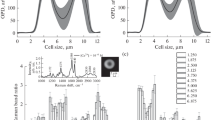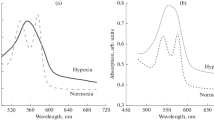Summary
Zn2+ has been allowed to equilibrate across the red cell membrane using two agents that increase membrane permeability to this ion: the ionophore A23187 and the specific carrier ethylmaltol. Extracellular free Zn2+ was controlled with EGTA (1,2-di(2-aminoethoxy)ethane-NNN′N′tetra-acetic acid)) buffers, except in the case of ethylmaltol, which itself acts as a buffer. Measurement of cellular zinc content at different levels of free Zn2+ facilitated the study of intracellular Zn2+ binding. It was also possible to estimate intracellular free Zn2+ concentration in untreated cells using a “null-point” technique. Intracellular zinc was found to consist of an inexchangeable component of about 129 μmol/1013 cells and an exchangeable component of 6.7±1.5 μmol/1013 cells, with a free concentration of about 2.4×10−11 m. The main component of Zn2+ buffering is hemoglobin, with a dissociation constant of about 2×10−8 m.
Similar content being viewed by others
References
Bettger, W.J., Taylor, C.G. 1986. Effects of copper and zinc status of rats on the concentration of copper and zinc in the erythrocyte membrane.Nutr. Res. 6:451–457
Ferreira, H.G., Lew, V.L. 1976. Use of ionophore A23187 to measure cytoplasmic Ca buffering and activation of the Ca pump by internal Ca.Nature 259:47–49
Flatman, P.W., Lew, V.L. 1980. Magnesium buffering in intact human red blood cells measured using the ionophore A23187.J. Physiol. 305:13–30
Foote, J.W., Delves, H.T. 1984. Albumin bound and α2-macroglubolin bound zinc concentrations in the sera of healthy adults.J. Clin. Pathol. 37:1050–1054
Galdes, A., Vallee, B.L. 1983. Categories of zinc metalloenzymes.In: Metal Ions in Biological Systems. H. Sigel, editor.15:1–54, Marcel Dekker, New York
Gilman, J.G., Brewer, G.J. 1978. The oxygen-linked zinc-binding site of human haemoglobin.Biochem. J. 169:625–632
Giroux, E.L., Henkin, R.I. 1972. Competition for zinc among serum albumin and amino acids.Biochim. Biophys. Acta 273:64–72
Grider, A., Bailey, L.B., Cousins, R.J. 1990. Erythrocyte metallothionein as an index of zinc status in humans.Proc. Natl. Acad. Sci. USA 87:1259–1262
Harris, W.R., Keen, C. 1989. Calculations of the distribution of zinc in a computer model of human serum.J. Nutr. 119:1677–1682
Hider, R.C., Ejim, L., Taylor, P.D., Gale, R., Huehms, E., Porter, J. 1990. Facilitated uptake of zinc into human erythrocytes. Relevance to the treatment of sickle-cell anaemia.Biochem. Pharmacol. 39:1005–1012
Kalfakakou, V., Simons, T.J.B. 1990. Anionic mechanisms of zinc uptake across the human red cell membrane.J. Physiol. 421:485–497
Magneson, G.R., Puvathingal, J.M., Ray, W.J. 1987. The concentrations of free Mg2+ and free Zn2+ in equine blood plasma.J. Biol. Chem. 262:11140–11148
Martell, A.E., Smith, R.M. 1974. Critical Stability Constants: Amino Acids. Vol. 1. Plenum, New York
Martell, A.E., Smith, R.M. 1982. Critical Stability Constants: First Supplement. Vol. 5. Plenum, New York
Ohno, H., Doi, R., Yamamura, K., Yamashita, K., Iizuka, S., Taniguchi, N. 1985. A study of zinc distribution in erythrocytes of normal humans.Blut 50:113–116
Peck, E.J., Ray, W.J. 1971. Metal complexes of phosphoglucomutase in vivo. Alterations induced by insulin.J. Biol. Chem. 246:1160–1167
Pfeiffer, D.R., Lardy, H.A. 1976. Ionophore A23187: The effect of H+ concentration on complex formation with divalent and monovalent cations and the demonstration of K+ transport in mitochondria mediated by A23187.Biochemistry 15:935–943
Rifkind, J.M., Heim, J.M. 1977. Interaction of zinc with hemoglobin: Binding of zinc and the oxygen affinity.Biochemistry 16:4438–4443
Scarpa, A., Brinley, F.J., Dubyak, G. 1978. Antipyrylazo III, a “middle range” Ca2+ metallochromic indicator.Biochemistry 17:1378–1386
Simons, T.J.B. 1987. Optical probes for Zn2+ ions.J. Physiol. 394:6P
Simons, T.J.B. 1990. An approach to the estimation of free zinc in human red blood cells.J. Physiol. 423:47P
Smith, R.M., Martell, A.E. 1989. Critical Stability Constants: Second Supplement. Vol. 6. Plenum, New York
Tupper, R., Watts, R.W.E., Wormall, A. 1952. Some observations on the zinc in carbonic anhydrase.Biochem. J. 50:429–432
Van Wouwe, J.P., Veldhuizen, M., DeGoeji, J.J.M., Van den Hamer, C.J.A. 1990. In vitro exchangeable erythrocytic zinc.Biol. Trace Element Res. 25:57–69
Author information
Authors and Affiliations
Rights and permissions
About this article
Cite this article
Simons, T.J.B. Intracellular free zinc and zinc buffering in human red blood cells. J. Membrain Biol. 123, 63–71 (1991). https://doi.org/10.1007/BF01993964
Received:
Revised:
Issue Date:
DOI: https://doi.org/10.1007/BF01993964




